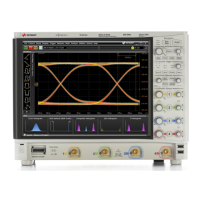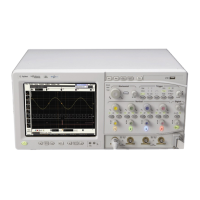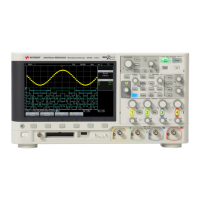Troubleshooting 4
S-Series Oscilloscopes Service Guide 61
Types of Faults
The fact that a fault on one sequencer causes LEDs corresponding to other
sequencers to illuminate will help you determine which LED is the root of the
problem.
When a fault occurs on a given sequencer, it notifies the other three using the
Fault signal. The other three sequencers also report it as an External Fault. For
example, if the first sequencer has an over-voltage on channel 1, it will report an
External Fault with channel 1 as the source. The other three sequencers will report
it as an External Fault with the source as Channel 4.
Similarly, if the first sequencer has an under-voltage failure on +12V, it will report a
Reset Fault on channel 1 and the other three sequencers will report External
Faults on channel 4. Any fault on one of the sequencers always reports an External
Fault on channel 4 on the other three sequencers. Look for the fault that is not an
External Fault on channel 4 as the cause of the shutdown.
If all four sequencers report an External Fault on channel 4, it is more difficult to
determine the real source. It could be on any of the Channel 4 sources, an
over-temperature fault (look for the over-temperature LED to light), or an
FPGA-issued fault.
Sequence Fault: Occurs when a supply does not come up in time during a
power-on sequence.
Reset Fault: Occurs if the oscilloscope shuts down during the monitor phase
because a supply went under voltage. This fault is probably due to the supply
failing to an off state or the load becoming too much for the supply.
Command Fault: Occurs when the ON sequence to one of the sequencers goes
HIGH to initiate a turn-on, but then goes LOW before the turn-on sequencing
finishes. Similarly, if the ON signal goes HIGH during sequencing off, a Command
Fault occurs. This kind of fault indicates something is going wrong with the ON
signal. This problem will most likely happen on the first sequencer. The ON signal
is driven by the minimum on-time limiter. There could be a problem here as well.
External Fault: An External Fault can be caused by several failures. If a supply
goes over-voltage, an external fault is issued. If the over-temperature sensor or
FPGA issues a fault, it will be displayed as an external fault on channel 4. This
presents an ambiguous case as an External Fault on channel 4 could occur for
multiple reasons. To help determine the cause, the over-temperature LED will light
during an over-temperature fault. However, this LED does not latch to failure.
Once the oscilloscope cools to below the over-temperature condition, the LED will
turn off. The main cause of an over-temperature fault is a stopped fan or blocked
air inlet. Check for these causes and power the oscilloscope back up. If it
continues to shut down, it could be a bad over-temperature sensor or comparator
circuit.

